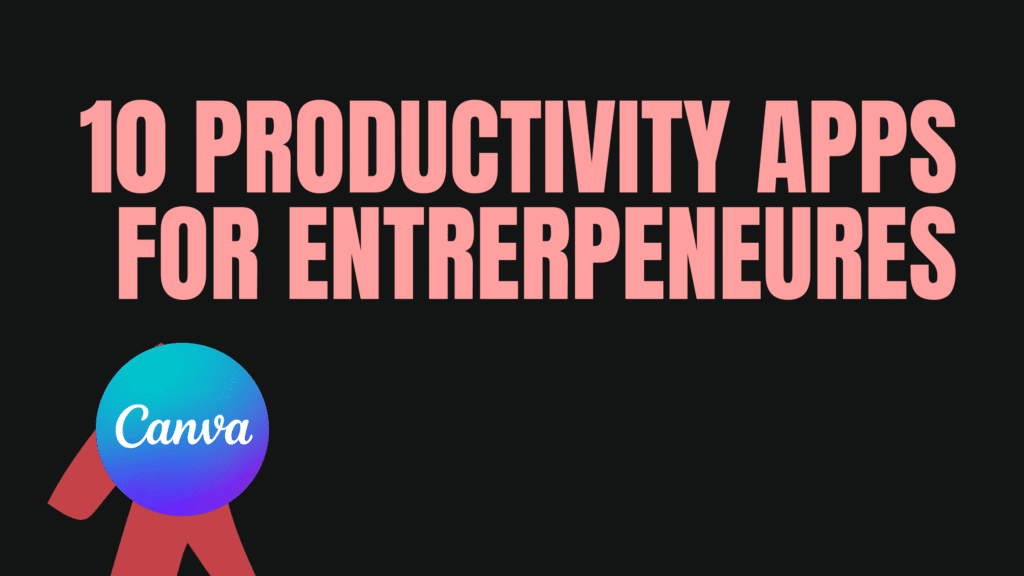
Table of Contents
Running a business is no small feat. As an entrepreneur, your time is your most valuable asset. But between meetings, marketing, client demands, and growth plans — productivity often takes a backseat.
The good news? Small changes in your workflow can unlock massive results.
In this post, we’ll explore 15 science-backed and experience-tested productivity hacks for entrepreneurs. These strategies will help you work smarter, stay focused, and scale faster — without burning out.
Productivity Hacks for Entrepreneurs
🚀 1. Start Your Day with a CEO Morning Routine
The way you start your day determines how productive it will be.
High-performing entrepreneurs don’t wake up and check emails first thing. Instead, they prioritize:
- • 10 minutes of planning (use a productivity planner):
Before jumping into tasks, spend a few minutes reviewing your calendar, setting top 3 goals for the day, and breaking down key tasks. This clarity prevents aimless multitasking. - • Physical activity or light stretching:
Moving your body increases blood flow to the brain, improves mood, and boosts focus. It can be a full workout, a short walk, or even desk stretches. - • A short journaling session or gratitude practice:
Writing down what you’re grateful for or journaling thoughts reduces stress, increases optimism, and enhances mental clarity — perfect for a focused start. - • Reviewing top 3 business goals:
Remind yourself of the bigger picture. It aligns your actions with your vision and keeps you from getting caught in small, reactive tasks.
🧠 Why it works: Morning routines reduce decision fatigue and give you momentum for the day.

📌 2. Use Time Blocking Instead of To-Do Lists
To-do lists are endless and often overwhelming. Replace them with time blocks.
Ho• Block 60–90 minute chunks for focused work:
Set dedicated times for deep work (e.g., writing, strategizing) where you won’t be interrupted. These are your most productive hours.
• Set buffer time between meetings:
Allow 10–15 minutes between meetings to decompress, take notes, and reset — preventing cognitive fatigue and calendar chaos.
• Dedicate blocks for admin, creative work, and deep strategy:
Separate blocks ensure your brain isn’t switching between low and high-level tasks, which kills productivity. Each block serves a specific mental zone.
🧠 Why it works: Time blocking increases focus by giving your brain a clear boundary around tasks.

🎯 3. Apply the 80/20 Rule (Pareto Principle)
Not all tasks are created equal. Focus on the 20% of activities that generate 80% of your results.
- • Analyze your top revenue-generating clients, channels, or habits:
Identify which clients bring the most income, which marketing channels convert best, and which daily habits yield the most results. - • Eliminate or delegate the rest:
If a task doesn’t bring meaningful results, drop it or assign it to someone else. Protect your energy for high-leverage work.
🧠 Why it works: This principle helps you prioritize what truly moves your business forward.
⏰ 4. Embrace the Power of “No”
Every “yes” to a distraction is a “no” to a priority.
Train yourself to:
- • Say no to low-value meetings:
Don’t accept every meeting invite. Ask: “Is this necessary?” If it can be solved via email or a Loom video, decline respectfully. - • Turn down offers or collaborations that don’t align with your goals:
Just because it’s a good opportunity doesn’t mean it’s the right one. Focus on alignment, not just potential. - • Use auto-responders and boundaries around your time:
Set expectations. Use out-of-office emails, Slack statuses, or calendar blockers to protect focus time.
🧠 Why it works: Saying no protects your time for deep, meaningful work.

⚡ 5. Batch Similar Tasks Together
Switching between types of tasks kills focus. Group tasks like:
- • Emails & DMs:
Instead of replying all day long, batch them into 2–3 specific windows per day. - • Content creation (videos, blogs, posts):
Block time to plan, write, design, and schedule multiple pieces at once — it saves hours and builds momentum. - • Client calls or sales follow-ups:
Handle these tasks back-to-back rather than scattered throughout the day. It reduces prep time and mental switching.
🧠 Why it works: Batching reduces context switching and increases flow state.
💻 6. Leverage AI and Automation Tools
Don’t waste time doing tasks tech can do faster.
Use tools like:
- • Zapier – automate workflows between apps:
Connect tools like Gmail, Slack, Notion, and Stripe so tasks happen automatically — like saving email attachments to Google Drive or tagging leads in your CRM. - • Notion or ClickUp – manage tasks and SOPs:
Use these tools to centralize your to-dos, documentation, and projects so your team is aligned and nothing falls through the cracks. - • ChatGPT or Jasper – draft emails, content, or research:
Let AI help with ideation, outline creation, or first drafts — saving hours of mental energy.
🧠 Why it works: Automating repetitive tasks frees up time for strategic thinking.
🧭 7. Plan Weekly, Not Just Daily
Set aside time every Sunday or Monday to:
- • Review KPIs:
Track key performance indicators (revenue, conversion, engagement, etc.) to know what’s working. - • Set weekly priorities:
Choose 3–5 needle-moving goals you must accomplish this week. This gives you direction. - • Allocate time blocks in your calendar:
Once your weekly goals are set, assign time to actually work on them so they don’t get lost in daily chaos. - • Reflect on what worked and what didn’t:
This helps you refine your strategies and avoid repeating unproductive habits.
🧠 Why it works: Weekly planning aligns your short-term actions with long-term goals.
🔒 8. Use the 2-Minute Rule
• If something takes less than 2 minutes, do it immediately:
Reply to a quick message, file a receipt, or schedule a call now — it’s faster than storing it as a task.
• Don’t schedule it, don’t snooze it — just do it:
Tiny tasks multiply when postponed. Knock them out while they’re fresh.
🧠 Why it works: Small tasks left undone create mental clutter. This clears your mind quickly.
📵 9. Create a Distraction-Free Work Environment
Distractions are productivity killers. Protect your focus with:
- • App blockers (like Freedom or Cold Turkey):
Temporarily block distracting websites and apps during focus periods so you’re not tempted. - • A minimalist workspace:
Clear your desk of clutter, digital or physical. Visual clutter leads to mental clutter. - • Turning off notifications during deep work:
Use “Do Not Disturb” mode to stay in the zone and silence pings from Slack, WhatsApp, or email.
🧠 Why it works: Fewer interruptions = more creativity and efficiency.
🎧 10. Work with Focused Sprints (Pomodoro or 90-minute Cycles)
The• 25/5 Pomodoro cycles (25 minutes work, 5 minutes rest):
These short bursts of focus help you stay energized and avoid fatigue.
• 90-minute deep work sessions followed by 20-minute breaks:
Ideal for more intensive tasks like writing, coding, or designing. Your brain naturally functions in 90-minute cycles.
🧠 Why it works: Cycles prevent burnout and boost mental sharpness.
👥 11. Delegate or Outsource Low-Value Tasks
Entrepreneurs often try to do everything — which slows down growth.
Delegate:
- • Customer support:
Train someone or use a VA to handle FAQs, refunds, or ticket systems. - • Admin tasks:
Calendar scheduling, invoice creation, data entry — let someone else manage them. - • Social media scheduling:
Use tools like Buffer, Later, or hire a social media assistant to schedule weeks of content in advance. - • Design, editing, or web maintenance:
Hire freelancers for specialized tasks so you can focus on your zone of genius.
🧠 Why it works: Freeing your time from $10/hr tasks lets you focus on $1,000/hr decisions.
🛠️ 12. Build SOPs (Standard Operating Procedures)
Stop solving the same problem twice.
Document recurring processes like:
- • Onboarding clients:
Create a step-by-step process for welcoming new clients, sending contracts, and gathering info. - • Posting content:
Document the steps to create, format, schedule, and promote your content — especially if you’re handing it to a team. - • Managing refunds or customer queries:
A clear SOP reduces back-and-forth and ensures consistency in service delivery.
🧠 Why it works: SOPs make delegation easier and build a scalable business foundation.
🧘 13. Protect Your Mental & Physical Health
Productivity isn’t just about tools. It’s about energy.
- • Sleep at least 7 hours:
Sleep improves decision-making, memory, and emotional regulation. Skimping on rest leads to burnout. - • Exercise 3–4 times a week:
Regular movement improves brain function, reduces stress, and boosts energy. - • Eat brain-friendly foods (protein, healthy fats, greens):
What you eat affects your mental clarity. Fuel your body like the high-performing machine it is. - • Take mental breaks or meditate:
Short resets prevent mental overload. Even 5 minutes of mindfulness can refocus your attention.
🧠 Why it works: A healthy entrepreneur can outwork, out-think, and outlast the competition.
🧾 14. Set Monthly Reviews and Scorecards
Each month, track:
- • Revenue:
Track your monthly income, expenses, and profitability to make smarter decisions. - • Customer acquisition:
Monitor where new clients are coming from. Double down on high-performing channels. - • Task completion rates:
See how much of your planned work actually gets done — this can highlight unrealistic planning or time leaks. - • Personal focus/happiness score:
Rate how well you stayed focused and how happy/energized you felt. Business success means little without well-being.
Use tools like Notion, Excel, or a physical planner.
🧠 Why it works: Regular reviews show patterns, bottlenecks, and growth opportunities.
🧠 15. Learn to Let Go of Perfection
Done is better than perfect. Trying to perfect every email, blog post, or product can waste time.
Set deadlines. Launch fast. Improve later.
• Set deadlines:
Having a time limit forces action. Don’t let perfection delay progress.
• Launch fast:
Get your product, content, or idea out there. Feedback is better than waiting for “perfect.”
• Improve later:
Use real-world data to refine. Nothing is ever perfect — just better over time.
🧠 Why it works: Speed of execution often beats perfection in business.
Final Thoughts
Productivity for entrepreneurs isn’t about working 16-hour days. It’s about using your time intentionally, setting boundaries, and investing your energy into what truly matters.
Start small. Choose 2–3 of these hacks and implement them this week.
📈 Over time, you’ll notice:
- Greater clarity in decision-making
- More time for creative strategy
- Faster business growth
🔄 Ready to Transform Your Business Workflow?
If you found this guide helpful, consider give a comment.
